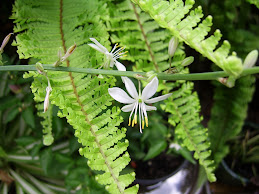(oops! he lost that bit of his left wing when I tried to photograph his hind-wings)

***************
Tally 89 + 7 = 96
(two doubtful- seedlings not thriving)
Cheers
Xanthorrhoea...(Grass Trees) A Blog about the Grass Trees in my garden and how grow plants from the seeds they produce. Thankfully not a hard task! Cheers!

Tally 89 + 7 = 96
(two doubtful- seedlings not thriving)
Cheers
 *********
*********Tally 2 new babies = 87 ... (Pic's later)
87+7 =94
Cheers
Here we see a green leaf added to cocoon, under that leaf is the white spotted caterpillar from the previous photo, and it happened overnight! What a little cheater, used most of his companions cocoon and only added 1 leaf!!! (the small green leaf above the flashed yellow leaf)

***********
An update about the caterpillars on my Crown of Thorns.(Euphorbia splendens), they are possibly Croton Caterpillars (Achaea janata) or his cousin ? due to not having white dots in the head area... I found this information here and from the very helpful Don Herbison-Evans.
 My Plant is growing ever Slimmer!
My Plant is growing ever Slimmer!**************
Grass Tree Tally 84 seedlings + 7 = 91
(I also had the 2 doubtful plants die and planted 4 more seeds)
 One of the doubtful ones died yesterday, the above one came onto that list so I still have 2 in doubt! The Tally is 85 seedlings.
One of the doubtful ones died yesterday, the above one came onto that list so I still have 2 in doubt! The Tally is 85 seedlings.
***********
Something a little different...
I have one of these plants in a pot, not sure of the name, something starting with a P I think!
It is a bit like a cactus as it has treacherous spikes on the stalks!
 It has 4 temporary residents!
It has 4 temporary residents!(click to enlarge photo to see spines)
 They are eating their house Down!
They are eating their house Down! I have no idea what sort of Butterflies they turn into? (if anyone knows feel free to tell me) I'm leaving them though... I will probably lose 1/2 the plant by the time they are through!
The amazing thing about it is, How the caterpillars can climb about on the plant when they are so soft! and the plant so spiky! Cheers
Cheers




Grass Trees… Xanthorrhoea species only grow in
They are very slow growing, but mature trees are centuries old, the lifespan can be 600 years! Unfortunately they have been reduced due to careless land clearing and land development. Respect for this species is easy when one considers also the valuable use to humans.
Without destroying the tree, Aboriginals ate the white, tender sections of leaf bases and roots, and collected the seeds to grind into flour. The resin at the base waterproofed their canoes, fixed their axe heads and spears. They also fermented the nectar to have a celebratory brew!
Early Colonists were also inventive, using the resin for their dwellings on floorboards and walls, stove polish, soaps, perfumes, incense in church and later in the manufacture of early gramophone records! Plant this Australian landscape icon.
It is fire tolerant, frost hardy, and drought resistant.










































